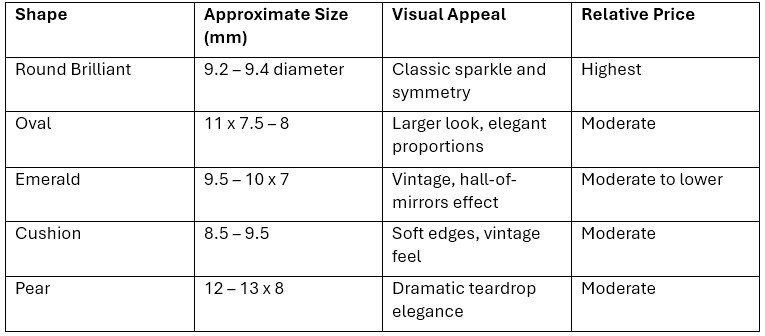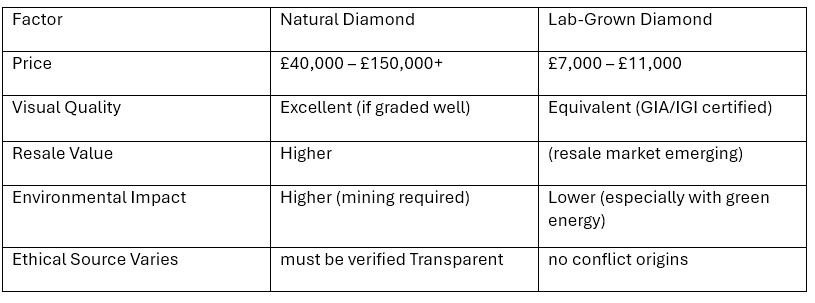The Definitive Guide to Acquiring a 3 Carat Diamond Ring
There is something undeniably commanding about a 3 carat diamond ring. It does not simply sit on the finger; it speaks. This is not a casual purchase. It signals a significant chapter in one’s life, whether it’s an engagement, an anniversary, or a celebration of personal success. Its presence is powerful, its message unmistakable.
In today’s market, the path to owning such a jewel has widened. The rise of lab-grown diamonds has made this size more accessible than ever before, while still offering remarkable brilliance and quality. But the scale of the stone brings a unique set of considerations that go far beyond basic carat weight. Whether you are new to diamond buying or already familiar with the basics, the journey to securing a 3 carat ring demands sharp attention to detail.
This guide provides clarity, expert insight, and practical benchmarks. It will help you avoid costly pitfalls, understand what truly drives value, and select a piece that will continue to bring pride and pleasure for years to come.
Understanding What 3 Carat Really Means
A common misunderstanding among first-time buyers is to equate carat with size. In reality, a carat is a measurement of weight, not dimensions. One carat equals exactly 200 milligrams. That means a 3 carat diamond weighs 0.6 grams.
This figure, however, tells only part of the story. How the diamond appears to the eye is determined just as much by how it is cut as how much it weighs. A poorly cut diamond can look smaller and sparkle less, even if it is technically heavier. This distinction is especially important at the 3 carat mark, where proportions can either elevate or diminish the stone’s beauty.
The Role of Cut and Shape
The cut of a diamond refers not to its shape but to the precision with which it has been faceted. A well-cut diamond will reflect and refract light with brilliance and fire, creating the eye-catching sparkle that diamonds are known for. When poorly executed, even a large diamond can appear dull.
Then comes shape. The most popular is the round brilliant, prized for its light performance. But other shapes – such as oval, emerald, cushion, or pear – often create a larger appearance for the same weight. An oval diamond, for example, can appear significantly bigger than a round diamond of equal carat weight due to its elongated outline and wider surface area.
If the goal is visual presence, this can be a smart strategy. Understanding how different shapes spread their weight can help you maximise the impact of your chosen stone.
Typical Size of a Well-Cut 3 Carat Diamond
For context, a well-cut 3 carat round brilliant diamond generally measures around 9.2 to 9.4 mm in diameter and has a depth of 5.6 to 5.9 mm. These figures can vary depending on the precision of the cut, but they serve as a useful reference point.
Here is a breakdown of standard proportions:
Typical Measurements for a Round 3 Carat Diamond

These figures demonstrate that weight alone does not dictate the size that you see. Two 3 carat diamonds can look markedly different based on their cut, shape, and proportions.
What Determines the Price of a 3 Carat Diamond
The Four Cs Explained for High-Value Stones
When it comes to diamonds, cut, colour, clarity, and carat weight are the four pillars of valuation. For larger stones like a 3 carat diamond, their influence on price becomes even more significant.
- Cut: Always prioritise cut. An “Excellent” or “Ideal” grade ensures optimal sparkle. A poorly cut 3 carat stone, no matter how large, will underwhelm.
- Colour: Colourless grades (D-F) command the highest premiums. G or H grades can offer excellent value and still appear white, especially in platinum or white gold.
- Clarity: VS1 or VS2 are ideal for a clean appearance to the naked eye. Going any lower can reveal inclusions, which are more visible in a stone of this size.
- Carat Weight: The price does not rise in a straight line. A 3 carat diamond may cost up to ten times more than a 1 carat stone due to scarcity and demand.
Buyers should also consider the psychological impact of benchmark weights. A diamond weighing 2.95 carats can cost significantly less than one just over 3.00 carats, even though the size difference is negligible.
The Influence of Shape and Certification
Round diamonds remain the most expensive shape due to high demand and wastage during cutting. Fancy shapes (oval, emerald, pear) tend to offer better value and may appear larger. Certification also plays a major role. Always insist on independent grading from GIA, IGI, or HRD. These labs provide objective verification of a diamond’s properties, ensuring transparency and resale potential.
Natural vs. Lab-Grown Pricing
The market has seen a seismic shift with the rise of lab-grown diamonds. For a 3 carat diamond, the price gap is considerable. A high-quality lab-grown stone may cost £9,000, while a natural equivalent could exceed £100,000.
Estimated UK Price Range for 3 Carat Loose Diamonds (2025)

These figures exclude the ring setting, which typically adds £700 to £3,000 depending on design and metal choice. The difference in cost is substantial and may shape not just the choice of diamond, but the budget for the overall ring.
Fun Fact
The average face-up surface area of a 3 carat round diamond is around 69 mm², roughly the size of a UK five pence coin.
The Best Diamond Shapes for a 3 Carat Stone
The cut and shape you select will define not just the look of the ring, but how well the diamond performs in light and how large it appears. Below is a comparison of popular choices.
Popular Shapes for 3 Carat Diamonds

Each shape offers a different visual impact. Round and oval provide strong sparkle, while emerald and cushion cuts exude a quieter sophistication. The choice depends not only on personal preference but on hand size, style, and desired presence.
Choosing the Right Setting for a 3 Carat Diamond Ring
Classic and Contemporary Styles That Complement Larger Stones
With a diamond of this size, the setting does more than hold the stone in place. It frames the entire look and must be chosen as carefully as the diamond itself. It also plays a vital role in both protection and comfort.
Solitaire: Timeless and elegant, a solitaire setting lets the diamond take full focus. For a 3 carat stone, its simplicity enhances the natural beauty without overwhelming the hand. Clean lines and minimal metal ensure the eye is drawn straight to the brilliance of the centre stone.
Halo: A surrounding ring of small diamonds can make a 3 carat diamond appear even larger. This design boosts sparkle from every angle. However, it requires delicate balance; if overdone, it may detract from the main diamond’s prominence.
Hidden Halo: This subtler version places accent diamonds just beneath the central stone. It adds sparkle from side views without changing the face-up appearance. It’s an ideal way to add detail while preserving a clean silhouette.
Three-Stone: Flanked by two side stones, the 3 carat diamond takes on symbolic meaning – representing past, present, and future. It also allows for contrast in colour or shape, such as pairing a central round diamond with baguette or pear-shaped side stones.
Bezel: Encircling the stone in a metal rim, a bezel setting offers maximum protection. It has a sleek, contemporary look and suits those with active lifestyles. This style can slightly enlarge the diamond’s perceived size due to its clean, defined outline.
Security Considerations for Larger Stones
A stone of this scale requires special attention to how it is secured. The setting should not only protect the diamond but also be engineered to support its weight over time.
- Prongs: Six prongs typically offer greater security than four, especially for round diamonds. For shapes like emerald or pear, the number and placement of prongs are even more critical.
- Low vs. High Set: A low-profile setting reduces the risk of snagging or accidental knocks, making it suitable for daily wear. A higher setting may add drama but requires greater care.
- Craftsmanship: The quality of construction determines not just durability but long-term wearability. Thin or fragile bands are unsuitable for a stone of this weight.
Selecting the Metal That Enhances and Protects
The metal you choose influences both style and function. For a 3 carat diamond, durability and colour harmony with the stone are essential.
Platinum: Extremely durable and naturally white, platinum does not require re-plating and holds the diamond firmly. It is hypoallergenic and retains its shine, though it does develop a soft patina over time.
White Gold: More affordable than platinum and equally bright in appearance, white gold is often rhodium-plated to achieve its lustre. It will need re-plating every few years to maintain its finish.
Yellow Gold: Classic and warm, yellow gold can flatter diamonds with a slightly warmer hue. It also offers good contrast, making the diamond appear whiter.
Rose Gold: With a romantic blush tone, rose gold works well with both vintage and modern styles. Its copper content adds strength, making it a durable option.
When choosing the band, consider width and balance. Very thin bands can look disproportionate under a 3 carat stone. The band should visually and structurally support the diamond, without compromising comfort.
Certification Is Non-Negotiable
Why It Matters for a 3 Carat Purchase
No matter how beautiful a diamond appears, its true value lies in verified facts. Certification from a trusted gemological lab confirms the stone’s identity and attributes. For a purchase of this scale, it is the buyer’s best protection.
- GIA (Gemological Institute of America): Regarded as the highest authority, GIA certificates are precise and respected worldwide.
- IGI (International Gemological Institute): Particularly dominant in the lab-grown diamond sector, IGI offers thorough analysis and rapid turnaround.
- HRD (Hoge Raad voor Diamant): A well-established European lab based in Antwerp, known for detailed assessments.
The certificate will outline all major quality attributes, including cut, clarity, colour, and fluorescence, along with a clarity plot showing inclusions. This documentation is essential for valuation, insurance, resale, and peace of mind.
What to Avoid
Be wary of sellers who offer diamonds without certification or use little-known in-house grading reports. Without independent verification, any stated attributes are unreliable. Also avoid certificates that do not include a clarity plot, especially for diamonds over 2 carats.
Lab-Grown or Mined Diamond? Understanding the Difference
This is not just a question of price. The decision between natural and lab-grown touches on ethics, aesthetics, and long-term expectations.
Lab-Grown Diamonds: Identical to natural diamonds in every way except origin. They are grown using advanced technology in a controlled environment. Prices are considerably lower, making them an appealing choice for buyers seeking size and quality within budget.
Natural Diamonds: Formed over billions of years, natural diamonds hold traditional appeal and stronger resale potential. Their geological origin adds an emotional and cultural weight for many buyers.
Table 4: Key Comparison of 3 Carat Diamond Types

The right choice depends on personal priorities. There is no objectively superior option. For many, the ethical and economic advantages of lab-grown diamonds make them a smart and modern alternative.
Making the Purchase: Tips for a Successful Buying Journey
Where to Shop and Who to Trust
Seek out established jewellers with a reputation for integrity. In the UK, areas such as Hatton Garden in London remain trusted centres of diamond expertise. Many shops offer bespoke services, allowing buyers to choose a loose diamond and collaborate on a custom ring design.
Look for retailers who offer:
- GIA or IGI certified diamonds
- Transparent pricing and return policies
- Positive customer reviews
- Full documentation for insurance and valuation
Design for Comfort and Daily Life
A 3 carat diamond is suitable for daily wear, but lifestyle matters. If the wearer leads an active or hands-on lifestyle, a more protective setting such as a bezel or low basket may be prudent. Also consider the practicality of prong security, ring height, and cleaning maintenance.
Getting the Ring Insured
Insuring a 3 carat diamond ring is essential. This is not just a matter of protecting against theft or damage – it is about peace of mind. Choose a specialist jewellery insurer and provide them with a detailed valuation from the retailer.
Coverage should include:
- Worldwide loss or theft
- Accidental damage
- Replacement value based on current market conditions
Is a 3 Carat Diamond Ring Right for You?
The answer lies in the occasion, the lifestyle of the wearer, and the emotional value you place on the piece. While traditionally reserved for engagements or anniversaries, the lower entry cost of lab-grown diamonds means a 3 carat ring is increasingly seen as a self-gift or personal milestone celebration.
Whether chosen as an expression of love, independence, or taste, it is a ring that will not go unnoticed. With the right shape, setting, and attention to detail, it will carry meaning, sparkle, and satisfaction for decades to come.



